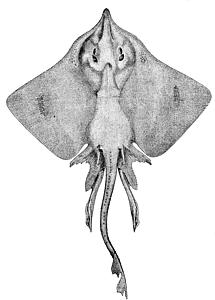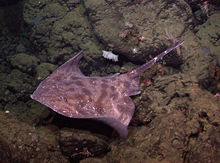Difference between revisions of "Skate" - New World Encyclopedia
(import credit version number) |
(applied ready tag) |
||
| Line 1: | Line 1: | ||
| − | {{ | + | {{Ready}} |
{{Taxobox | {{Taxobox | ||
| color = pink | | color = pink | ||
| Line 24: | Line 24: | ||
Skates are [[benthic]] (bottom-dwelling) and are found throughout the world from [[continental shelf|continental shelves]] down to the [[abyssal zone]]. They are [[oviparous]] fishes, laying eggs in a horny case known as a [[mermaid's purse]]. It is thought that egg-laying in skates is an evolutionary reversal, that is, skates are descended from [[Ovoviviparity|ovoviviparous]] ancestors.<ref>{{FishBase family | family = Rajidae | month = August | year = 2005}}</ref> | Skates are [[benthic]] (bottom-dwelling) and are found throughout the world from [[continental shelf|continental shelves]] down to the [[abyssal zone]]. They are [[oviparous]] fishes, laying eggs in a horny case known as a [[mermaid's purse]]. It is thought that egg-laying in skates is an evolutionary reversal, that is, skates are descended from [[Ovoviviparity|ovoviviparous]] ancestors.<ref>{{FishBase family | family = Rajidae | month = August | year = 2005}}</ref> | ||
| − | The [[common skate]], ''Dipturus batis'', is the largest found in British waters. It has a long, pointed snout. However, the most common skate in British seas is the [[thornback ray]], ''Raja clavata''. They are frequently caught by [[trawling]]. Common skate and white skate are assessed as Critically Endangered by IUCN (World Conservation Union) and the fish is listed by the Marine Conservation Society as a "fish to avoid".<ref>[http://www.fishonline.org/advice/avoid/?item=35 "Fish to Avoid: Skate"] from the Marine Conservation Society, retrieved | + | The [[common skate]], ''Dipturus batis'', is the largest found in British waters. It has a long, pointed snout. However, the most common skate in British seas is the [[thornback ray]], ''Raja clavata''. They are frequently caught by [[trawling]]. Common skate and white skate are assessed as Critically Endangered by IUCN (World Conservation Union) and the fish is listed by the Marine Conservation Society as a "fish to avoid".<ref>[http://www.fishonline.org/advice/avoid/?item=35 "Fish to Avoid: Skate"] from the Marine Conservation Society, retrieved November 11, 2006</ref> |
| Line 60: | Line 60: | ||
* [[Jenny Haniver]], a fake sea monster created from a skate corpse | * [[Jenny Haniver]], a fake sea monster created from a skate corpse | ||
| − | == | + | ==Notes== |
<references /> | <references /> | ||
==External links== | ==External links== | ||
| + | All links retrieved November 22, 2007 | ||
{{wiktionarypar|skate}} | {{wiktionarypar|skate}} | ||
{{cookbook}} | {{cookbook}} | ||
* ARKive - [http://www.arkive.org/species/GES/fish/Dipturus_batis/ images and movies of the common skate ''(Dipturus batis)''] | * ARKive - [http://www.arkive.org/species/GES/fish/Dipturus_batis/ images and movies of the common skate ''(Dipturus batis)''] | ||
| − | [[Category: | + | [[Category:Life sciences]] |
| − | [[Category: | + | [[Category:Animals]] |
| − | |||
| − | |||
| − | |||
| − | |||
| − | |||
| − | |||
| − | |||
| − | |||
| − | |||
| − | |||
{{credit|172623851}} | {{credit|172623851}} | ||
Revision as of 04:25, 23 November 2007
| Skates | ||||||||||||||
|---|---|---|---|---|---|---|---|---|---|---|---|---|---|---|
 Barndoor Skate, Dipturus laevis
| ||||||||||||||
| Scientific classification | ||||||||||||||
|
Skates are cartilaginous fish belonging to the family Rajidae in the superorder Batoidea of rays. They are carnivorous, feeding mostly on smaller fish and crustaceans. They have flat pectoral fins continuous with their head, two dorsal fins and a short, spineless tail. There are more than 200 described species in 25 genera.
Skates are benthic (bottom-dwelling) and are found throughout the world from continental shelves down to the abyssal zone. They are oviparous fishes, laying eggs in a horny case known as a mermaid's purse. It is thought that egg-laying in skates is an evolutionary reversal, that is, skates are descended from ovoviviparous ancestors.[1]
The common skate, Dipturus batis, is the largest found in British waters. It has a long, pointed snout. However, the most common skate in British seas is the thornback ray, Raja clavata. They are frequently caught by trawling. Common skate and white skate are assessed as Critically Endangered by IUCN (World Conservation Union) and the fish is listed by the Marine Conservation Society as a "fish to avoid".[2]
Genera
- Amblyraja
- Arhynchobatis
- Atlantoraja
- Bathyraja
- Breviraja
- Cruriraja
- Dactylobatus
- Dipturus
- Fenestraja
- Gurgesiella
- Irolita
- Leucoraja
- Malacoraja
- Neoraja
- Notoraja
- Okamejei
- Pavoraja
- Psammobatis
- Pseudoraja
- Raja
- Rajella
- Rhinoraja
- Rioraja
- Rostroraja
- Sympterygia
- Zearaja
See also
- Anacanthobatidae, the family of smooth skates.
- Jenny Haniver, a fake sea monster created from a skate corpse
Notes
- ↑ "Rajidae". FishBase. Ed. Ranier Froese and Daniel Pauly. August 2005 version. N.p.: FishBase, 2005.
- ↑ "Fish to Avoid: Skate" from the Marine Conservation Society, retrieved November 11, 2006
External links
All links retrieved November 22, 2007
Credits
New World Encyclopedia writers and editors rewrote and completed the Wikipedia article in accordance with New World Encyclopedia standards. This article abides by terms of the Creative Commons CC-by-sa 3.0 License (CC-by-sa), which may be used and disseminated with proper attribution. Credit is due under the terms of this license that can reference both the New World Encyclopedia contributors and the selfless volunteer contributors of the Wikimedia Foundation. To cite this article click here for a list of acceptable citing formats.The history of earlier contributions by wikipedians is accessible to researchers here:
The history of this article since it was imported to New World Encyclopedia:
Note: Some restrictions may apply to use of individual images which are separately licensed.

